Echoes of repetition
1st March 2019There are times when trip ideas get re-used. The unseasonal sunny weather that dominated the second week of February became a backdrop to some of this. Firstly, it lured me up to Great Ayton for a day spent around Roseberry Topping, Highcliffe Nab and Easby Moor. This was a variation of a route enjoyed more than a year earlier when snow and ice were dominant. Then, the ground conditions added a need for extra care that probably should have precluded an ascent of Roseberry Topping that was facilitated far better in conditions more typical of late spring or early summer.
A few days later, I was drawn to Earl Sterndale for a walk that took in the tops of both Parkhouse Hill and Chrome Hill. The latter was more friendly to those whose tolerance of exposure is more limited. Some might go up and over the former but I did an out and back trip to its summit before kinder gradients were descended in a northward direction. In the autumn of 2017, I had passed both on the way from Sterndale Moor to Buxton but avoided their summits on that equally pleasant sunny day.
Sometimes, there are stronger patterns of repetition there is one shared between 2010 and 2017. Both featured trips to Sweden and Aberdeenshire as well as marking the start and end of my time with a single employer. Because of the changeover in employment arrangements, the destination pairing has a certain eerie resonance for me.
Neither the Swedish or Aberdeen trips were my first to either place but it took a third visit to the former for more of a leisure focus to show itself. September 1997 saw my first visit to Aberdeen and that was for a scientific congress while business was the main motivation for those first two trips to Sweden. Even so, there opportunities for personal exploration offer themselves too because conferences cannot occupy you for all their duration and long sunny Swedish summer evenings made for pleasant strolling around both Södertälje and Stockholm.
The 2010 sojourn in Aberdeen allowed for more city strolling and a visit to Braemar only months after starting a new job. There was no mountain walking in 2017 but Stonehaven, Dunnottar Castle, Banchory, Crathes Castle and the Deeside Way more than occupied the time not spent on city wanderings. In fact, the idea of doing some castle visiting was a seed sown during the previous trip. That it preceded my leaving the company that I joined in 2017 by a matter of months made it a kind of a bookend to my time there.
One of the motivations for heading to Aberdeen for the 2017 Spring Bank Holiday weekend was as a means of dealing with the fact that I no longer enjoyed working where I was. Together with a second trip to Norway, it was intended to salve the lack of enthusiasm that I had for what I was doing but it was not to be a long term strategy so I made the difficult decision to leave my then employer and take a career break while I worked through the aftermath of a number of life events as well as working out what my future career direction might be.
It was after starting the career break, that I then headed to Stockholm for an extended weekend stay. My previous time in Sweden preceded a departure from a then current employer and information transfer was its purpose. Only weeks later, I was going to start with the employer that I left in 2017 so there was a curious symmetry about my actions. Naturally, city explorations were to follow with even Gothenburg receiving a fleeting visit. Tyresta National Park became the starting point for the longest hike that I enjoyed while in the country. The whole experience was vastly more restive than the preceding months and it would take more than a year before I started to explore places beyond British and Irish shores.
If I have my way, such juxtapositions as pairings of trip destinations and career changes may not be repeated in the future. Though there are other places to see and experience, I also hope to continue my Scottish and Scandinavian encounters. My choice would be that they do not need career upheavals to make them happen because we need to keep making more happy memories to get us through times that are more testing.
A curtailed Easter escape
27th December 2018At the end of January 2017, an idea came to mind. Preceding years had seen holidays being little more than elongated weekends and I fancied a little longer. Also, the idea of feeling ensconced in Edinburgh for a longer period of time appealed to me. Both thoughts came together to get me thinking of stretching the forthcoming Easter weekend by taking the preceding Thursday and the trailing Tuesday to make for a six-day trip to Scotland’s capital city.
The days were booked off from work and bookings made. An early train ticket purchase got me a great deal using advance purchase tickets, which was just as well given the cost of the hotel booking. At this stage in the year, the chance of a springtime sabbatical was a tenuous prospect though it had been discussed with my manager. The longer time off, unpaid as it was, required approval from more senior management and that took until March. That lack of notice meant that grander plans could not be made, which, in retrospect probably was just as well.
Circumstances
Though what I really needed was quiet time at home, I could not help myself and spent a pleasant weekend on the Isle of Man at the start of April, just before the Easter weekend. In hindsight, returning from there on Monday and departing again for Scotland on Thursday within the same week probably was asking too much and an Irish matter was to prove that. It threw me into indecision and pulled someone else through the proverbial emotional wringer as well. All was sorted in the end and there have been no lasting consequences, but such things did not half the weight on my mind at the time.
The result was that my Thursday departure was aborted, my non-refundable advance purchase ticket forfeited and my hotel booking cancelled. Though there was some money lost, there also was more money gained. A quandary descended on me at the same time and I ended up booking a journey to Edinburgh with National Express for the forthcoming Saturday morning as well as rebooking the hotel for fewer nights. Such an act still left me unconvinced but I went through with it.
Though there might have been an element of resolution regarding the piece of Irish business, there was a raw emotion evident during my journey north. The longer journey time was spent reading Mary Beard’s SPQR and taking a phone call from my brother. Some hot nourishment was enjoyed at Tebay motorway services as well.
When I reached Edinburgh, it was not as bright a day as the one that I had left in England. Occasional rain showers were a threat. Before I made for my lodgings, I pottered around St. Andrew’s Square and Princes Street Gardens. After settling into my room, I attended an Easter event in the heart of Edinburgh before retiring for the night.
A Wet Day around Glen Sax
Easter Sunday came wet in spite of suggestions of rain clearing away in any weather forecast. Even sitting out the morning in the hotel was to no avail. At other times, a day indoors might have sufficed but I felt other needs and braved the damp weather.
There were phone calls and text messages regarding a neighbour having passed away, and useful conversations were had on the bus to Peebles. Once there, a little wait by the Tweed seemed to be rewarded by a partial clearance of rain so I set off along a drove that I had not trodden for a good while. Grey skies lay all around and there was none of the pleasing light witnessed on the first Monday of June 2002 or what was to be savoured on a hot sunny day in June 2006. Nevertheless, I continued and others were out walking so it was not just any aberrant activity on my part.
If there were ever any ambitions to complete a round of the Glen Sax hills, poor visibility put paid to such an idea. Still, there were visits to Kailzie Hill, Kirkhope Law, Birkscairn Hill and Stake Law so I had gone further than any previous encounter with the place. As expected, wet ground was my lot and it was soggy in places too. Still, the walk was much needed regardless of this.
With the signs of any path becoming ever more tenuous and visibility declining all the while, I thought it to be best to return to the saddle between Stake Law and Birkscairn Hill to commence a descent down some steep slopes. These were negotiated more liberally than the path suggested by the OS map would have done. Zigzags were added to my course to ease the task sufficiently for the avoidance of any sense of cragfastness. Water entered my boots as I did so and wet feet were the result, another hint that my boots needed reproofing.
Soon enough, I was on the floor of the glen for a crossing of Glensax Burn to reach the sheep pens where I joined the track leading back towards Peebles. Though the air was heavy, the rain had stopped, and steady progress left me marvelling at how fast I was going. In fact, I hardly felt the length of the five kilometres to the gate near Gallow Hill where I again was on tarmac for the last stretch into Peebles to await the next bus back to Edinburgh.
The day had been satisfying and I still would like to complete that Glen Sax Round at some point. This needs an early start since the walk will be a long one but I now have some sense of how to make it happen. Also, a better day with plenty of daylight hours will be in order. Having a less cluttered life could help too, but the Easter Sunday 2017 walk started an emotional recovery that was much needed. The following day would take things further.
In Better Spirits along the John Buchan Way
Easter Monday got the benefit of a better forecast. Fancying the prospect of walking somewhere anew, I plumped for the John Buchan Way; another attempt at going around Glen Sax could wait. My choice also involved a hike from one place to another, something that I prefer to the idea of an out and back venture. Much like Glen Sax on Easter Sunday, it also offered much needed solitude and felt a world away from the usual run of my life.
There was a bit of dawdling around Peebles as I sought the actual route that the trail took on the way out from the town. Though grey, the morning was dry and I was to escape rain for most of the day with cloud breaking to leave bright sunshine holding sway before a late afternoon rain shower made a visit.
Once I had got as far as Peebles’ extremities, the next task was to go around Morning Hill and the path on the ground took a slightly different course from what my map suggested. The line taken was good enough for me so I was not about to pursue the matter. The course became clearer as I shadowed the Cademuir Plantation to reach a lane that would convey me around a hill topped with a fort.
The up and down course continued to take me through pastoral surroundings laden with signs reminding drivers that pregnant sheep were all around there. The hint was that they should slow down, but that naturally did not apply to pedestrian stravaigers like myself. Crossing Manor Water, I continued towards The Glack where I would leave tarmac tramping behind me for a while. That a pesky pothole had nagged an ankle was more reason for going over softer ground.
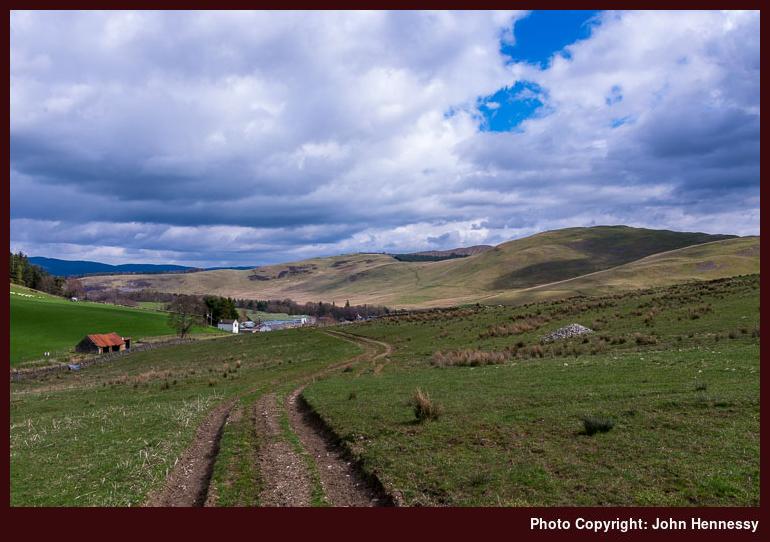
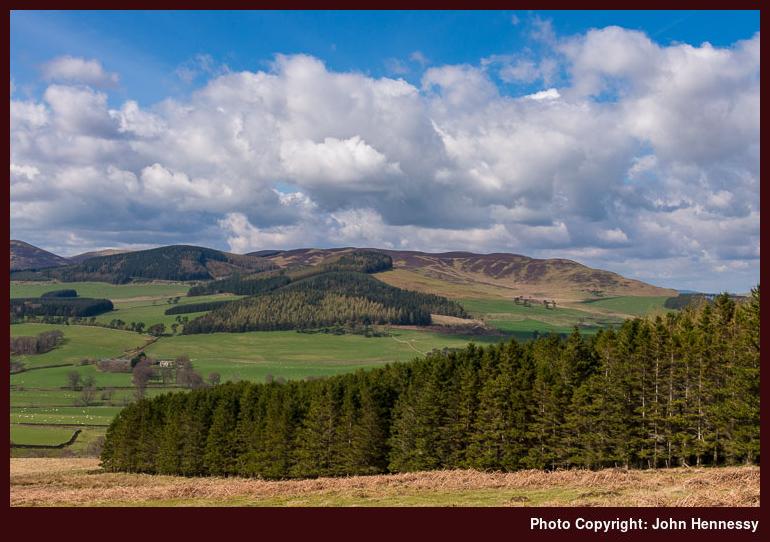
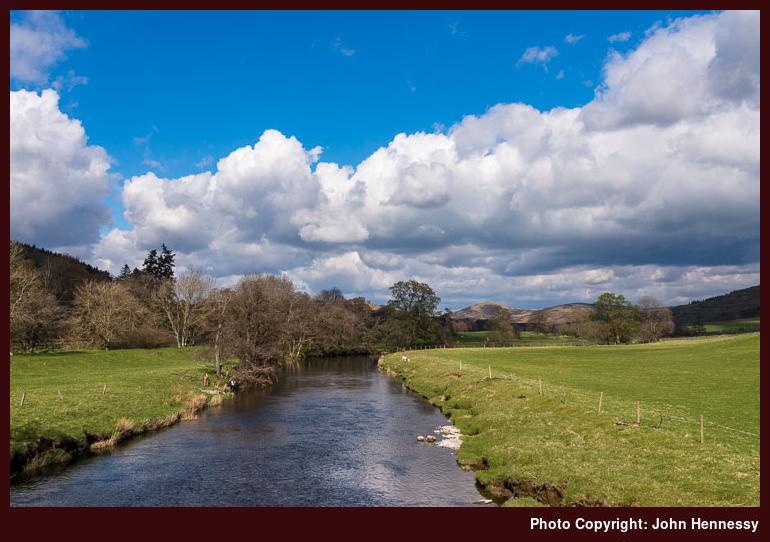
The way to Stobo took me through many fields as I threaded my way along Glack Hope and over the lower slopes of White Knowe and other neighbouring hills. As the route went this way and that, a certain amount of attention was needed so as not to wander off it until matters became simpler after Easter Dawyk. Any height that had been gained was being lost all the while as the A712 grew ever closer. Eventually, a second crossing of the River Tweed (the first had been in Peebles itself) was to reach the road and seek out another escape from tarmac.
If I was seeking a bus stop from which to get back to Peebles, there might have been some uncertainty about such a plan but I was seeking out the trail for Broughton. That was to shadow Easton Burn for much of the way to Hammer Rig. By then, any vestiges of pastoral living were petering out and I could feel that I was in wilder terrain though civilisation never was that far away.
It also helped that sunshine lit up the surrounding hillsides as I crossed some of their number. This was where hilltops like those of Hammer Knowe, Hog Knowe and Hopehead Rig acted as progress indicators while I wondered at how far I was going up Stobo Hope to reach the isolated output of Stobo Hopehead.
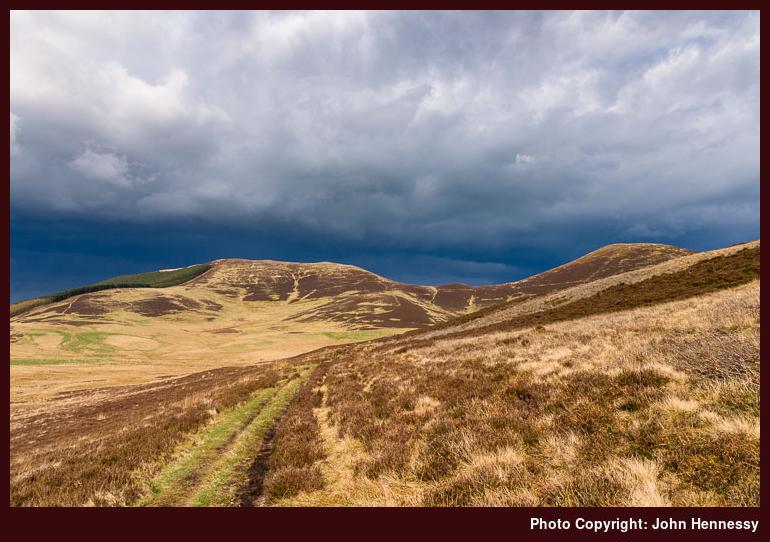
Dark grey cloud was gathering from the east while my surroundings remained sun-blessed but it was not about to last. Just beyond Hopehead Rig, the rain caught up with me to ensure a damp finish to my walk. It might have been nice to have retained sunshine for the descent beside such heights as Clover Law or Cat Cleuch Head but I hardly felt denied because of what else that have been there to savour.
It was dry when I reached a dampened and quiet Broughton and the bus stop was easy to find and I was there in plenty of time before the next departure. That meant I could stroll about the village a little and note the laid-back youths who were hanging around with one of their number set to be a fellow passenger on the bus back to Peebles.
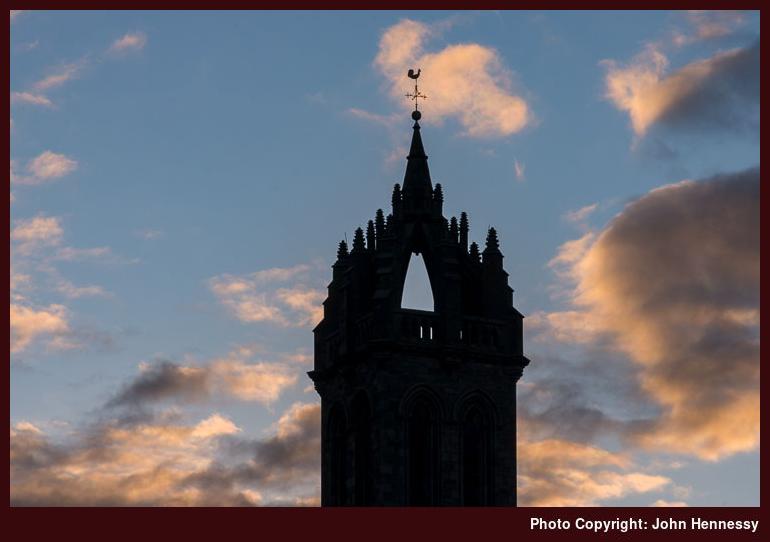
Once in Peebles again, there was time for strolling about the banks of the Tweed but the sun was not being so co-operative so photographic opportunities were limited. Maybe that was just as well given my need to return to Edinburgh before a southbound journey the next day.
Afterwards
The day after Easter Monday was when the matter in Ireland finally got sorted and I must admit some trepidation interrupted any peace of mind on the train from Edinburgh to Manchester. Any yapping on a phone by a Scottish NHS IT administrator was remediated before or at Carlisle and was a lesser intrusion in any event. At least, this train journey was one that I had booked back in January. On arrival in Macclesfield, I found out the good news from the other side of the Irish Sea and could look back on my weekend with satisfaction. Emotional rest was the order of service for the rest of the week until I realised how close my return to work was becoming.
Travel Arrangements
Train journey from Macclesfield to Manchester followed by a coach journey from Manchester to Edinburgh. Two return bus journeys between Edinburgh and Peebles. Bus journey from Broughton to Peebles. Return train journey from Edinburgh to Macclesfield with a change in Manchester.
Journeys of others
15th November 2018Before my career break, I found it difficult time to read a book and often lapsed into watch television documentaries on the BBC iPlayer. The situation got reversed after a book called Flow by Mihaly Csikszentmihalyi encouraged the practice. Whenever I feel an emotion that I do not want to remain, a TV watching binge never helped but reading a book causes movement and the feeling can be left in the past. It is as if someone else’s journey brings you along too.
Currently, that is taking on the shores of the Aran Islands in the company of Yorkshireman Tim Robinson. Reading his two part work on the islands has lain on my reading list for far too long and I started Stones of Aran: Pilgrimmage back in the noughties only never to get very far with it. My paper copy may be gone but I made a new start on its digital counterpart and it is reading well so far.
Handily, I visited Inishmore (Árainn, as Gaeilge) so the localities are not all that lost to me. If another visit were to happen, then Iaráirne could see an encounter as could the opposite end of the island if I feel sufficiently adventurous. Sightings of Inishmann (inis Meáin, as Gaeilge) or the Brannock Islands could be additional rewards for such endeavours. Before such things, more of Robinson’s works like Stones of Aran: Labyrinth and his Connemara Trilogy await and who knows what they might inspire?
The world described by Tim Robinson is not dissimilar in ambience to that described in Chris Townsend’s The Munros and Tops, another of this year’s reads. After that came John McPhee’s Coming into the Country and it proved to be a book in three very different sections. The first section features the Brooks Range with a narrative split in two with the second part preceding the first. It still hangs together well with the second and third sections featuring more of the folk that are attracted to the idea of a wild place away from the strictures of everyday living.
That unleashes tensions when trying to find a new state capital or dealing with the encroaching bureaucracy keen on keep a wild landscape as it is when you fancy exploiting its resources on a small scale. The act of taking a Caterpillar D9 bulldozer into wilderness oddly aroused my concern for the machine and not the landscape as might be expected. Maybe it reminded me of of abandonment in a big hostile world and there could be a wider theme there. In the end, McPhee finds himself siding with industrious Alaskans earning a living rather than others solely following their perhaps unrealisable dreams. They might fancy abandonment much like Christopher McCandless only to find that they still need humanity or that it continues to intrude on their world.
Stepping away from humanity awhile is a recurring theme in my own wanderings and it is why such places as the Scottish highlands and islands are as amenable to my ends as the wilder parts of other places. That also explains a certain interest in North America that was accompanied by perusal of writings about Lewis and Clark crossing the continent though that was a very dry read that I was happy to finish.
There is another recurring theme in all of this: you often find Robert Macfarlane appearing in these with either a recommendation or a foreword. That applies to the McPhee and Robinson works as much as that by Nan Shepherd on the Cairngorms. It might be that he is using his fame to restore older books to our notice but I reckon that I might be reading them anyway given how I have been collecting them onto a reading list in recent months.
Speaking of those older books, it is unlikely but if I ever were to wnat more but I might be tempted by the Gutenberg project if I wanted eReader files of works from a very different era by Heny David Thoreau or Raplh Waldo Emerson. They are out of copyright but a visit to either AbeBooks, The Literature Network or Scribd could serve a use if I fancied a wider selection of those still covered by such restrictions. With more new tomes that appeal to me, that is unlikely to happen just yet. Usefully, the time taken to complete any single volume should put a brake on any overspending. After all, it is better to acquire for reading than to decorate a bookshelf and horde more than you need.
Forthside wanderings
30th October 2018This year’s trips to Edinburgh have seen a developing trend: a tendency to go walking along the southern shore of the Firth of Forth. February saw me pottering along Edinburgh’s northern shores on a stroll that took me from Edinburgh’s city to and along the water of Leith before I headed west as far as Silverknowes where I caught a bus to Waverley train station where I caught my train home.
That necessarily cut off an approach to Cramond but the omission got addressed on a July visit when I walked along the coast west of Silverknowes before going inland along the banks of the River Almond and that was followed by a quick visit to the Cammo Estate before I found a bus stop from where I began my journey home. There was no crossing to Cramond Island because it was a time of high tide so examining tide times ahead of a coastal hike and that lesson was reinforced more recently.
As it happened, this past Saturday saw the longest stroll of the lot with my going west from North Berwick to Seton Sands. Mainly, it involved travel over sandy beaches and dunes as well as rocky shorelines. Many coastal rocky prominences like Bass Rock or Fidra caught my eye and led to photographic activity. Part of the John Muir Way was followed too, especially after a crossing of Aberlady Bay was stymied by the depth of Peffer Burn. That crossing left me wetter than was ideal but thoughts of getting cut off by an advancing tide spurred me along. Next time, a sighting of a beach watercourse on a map will cause me to be more cautious about my intentions than I was on this occasion.
Still, much sunshine was enjoyed and it did wonders for the coastal scenery much like on previous visits to the Edinburgh coastline in February and July. Unlike those days, cloud came in the afternoon and brought a little rain but that did nothing to take from what preceding better weather brought to me earlier in the day. My route had been inspired by one included in The Great Outdoors and offered something very different to other possibilities like the Pentland Hills or the Glen Sax round near Peebles. Both of those await future explorations now that the bracing sea air of the Forth has been savoured and there are other parts that need exploring so return visits to Edinburgh remain likely.
Sharing or sparing?
18th September 2018Having what is called a bucket list, a list of places that you would like to visit while you can, is common these days but I wonder if such a thing is all that desirable. By the its nature, the problems start when compiling a list of such ideas because chances are that you will select places that already are popular. That applies as much when perusing travel magazines or holiday brochures as it does when using social media.
One consequence of this is that certain locations become too popular for the sake of sustainability and that leads to restrictions that affect the independent traveller. South American destinations like Machu Pichu and Torres del Paine National Park come to mind here but the problem is spread around the world. Scotland’s Isle of Skye has experienced problems that never made the news before and you only have to see how many visit well promoted attractions like the Cliffs of Moher to see how many people visit a small number of locations in Ireland at a time during the high season.
This then poses something of a dilemma: do you cater for the visitor numbers or do you restrict them? With wilderness and conservation areas, there is a tendency to do the latter though it does have the consequence of pushing up visitor costs and that may have its benefits for local tourism businesses as you may find on a trip to places in either the Canadian Rockies or Alaska. When you add in short summer tourism seasons, the effect by necessity is more pronounced.
In other destinations, they add in facilities for the extra visitors with some decrying the effect that this has had on Spain’s Mediterranean coastline because of hotel and holiday apartment construction. Parts of the Alps are afflicted like this but in a different way: it is the infrastructure of skiing resorts that hardly help appearances in mountain country during the summer season. Both examples make you wonder at the appropriateness of such developments and they must tug at the heartstrings of anyone who adores mountain and coastal scenery.
Another aspect of any overdevelopment is that you can install something that encourages the otherwise unprepared into wild places without realise the possible dangers that are there. For instance, I seem to have inherited my father’s unease at cliff edges and my knowledge of how slippery limestone can be almost made me shout at people to keep back from the edge on a damp day hike around the Cliffs of Moher and Doolin. It is little wonder that staff are equipped with whistles to direct the unaware away from peril.
There is overcaution too and one example is the boardwalk on Cuilcagh Mountain and how incongruous it looks in the landscape through which it conveys people to the top of the hill shared between Cavan and Fermanagh, between Éire and Northern Ireland. It also does not help that it stops short of the top too but the boggy morass deters most. Another location where path development attracted adverse comment was at Sliabh Liag in County Donegal but it might be that some sense prevailed there in the end.
Hillwalking is a growing pastime in Ireland so there remains a lot to learn in a country where there is neither experience nor tradition of path and track building in such places. Thankfully, organisations like Mountain Meitheal and Mountaineering Ireland together with initiatives like Helping the Hills are starting to address this so lessons are learned from places like Scotland and applied to get sensible solutions to the growing problem of erosion on popular hills. It is something that needs attention as much as securing access for hill wandering in the first place.
The mention of countryside access brings me to another factor that causes some places to feel overloaded: a lack of alternatives. It is not everywhere that has the liberal access rights that are enjoyed in Scotland and across Scandinavia so there can be a very really reduction in the number of places where you can explore. The options may not stop you going to those better known places like Norway’s Preikestolen before finding other quieter hikes nearby as knowledge grows and maps feel more confiding.
It is this last point that inspires the title and the theme runs through Fiona Reynolds’ The Fight for Beauty, a book that I read last autumn. It is not for nothing park rangers in Denali National Park tell you not to walk one after another in a group so a path never develops and that everyone’s backcountry journey is their own. When there is plenty of land for all, we can spread out and find our own space to recharge weary spirits. That is easier when we are not retracing the steps of others all the while and it can have a lighter impact on the countryside too with less erosion caused by many feet and much path widening. While it can be true that we get confined by or own lack of knowledge, physical restrictions caused by not having enough other places to go hardly help either. Overcoming both might be the ultimate answer to the visitor management conundrum.